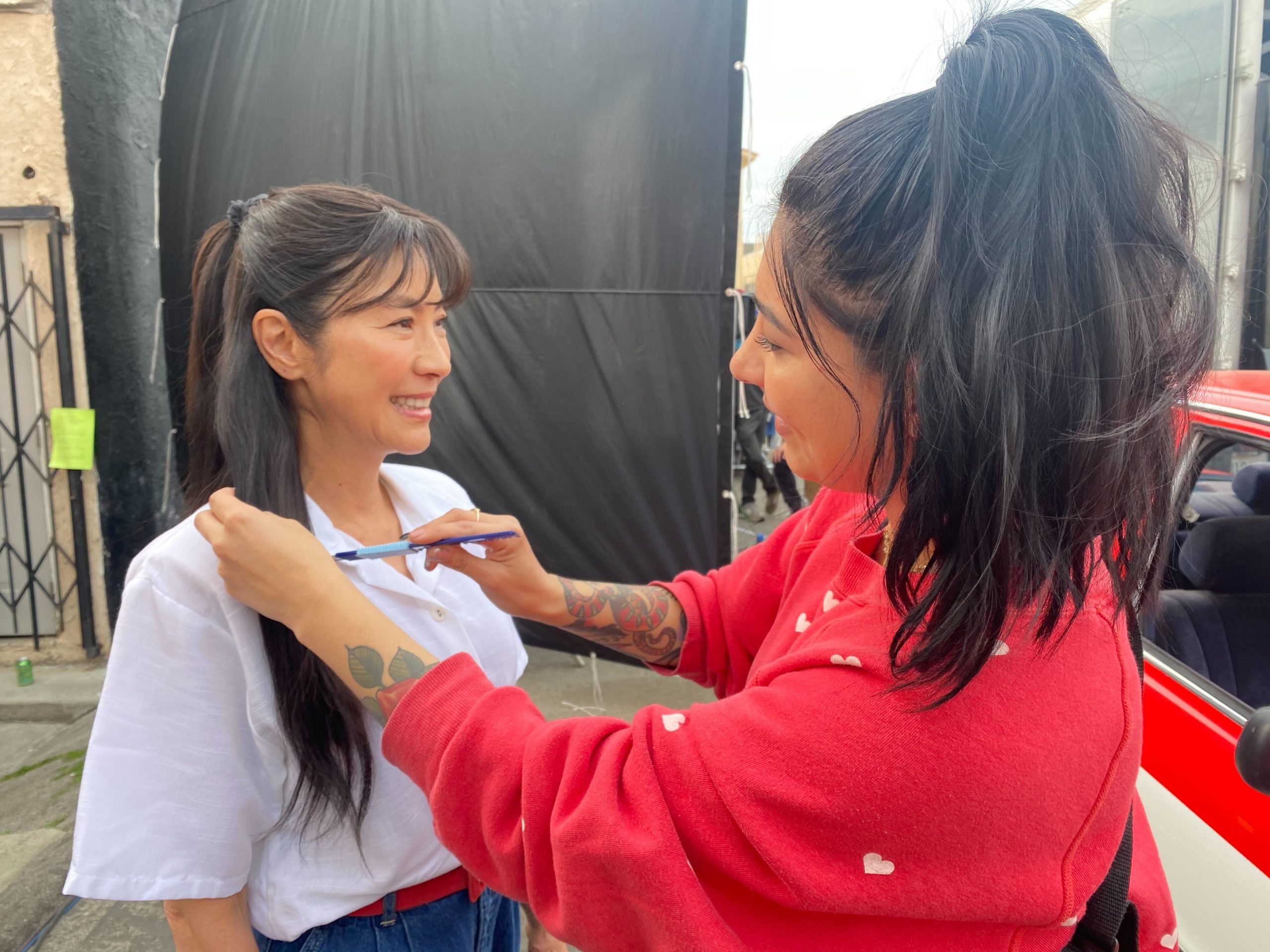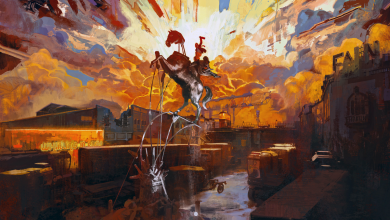Recasting the Spotlight: Meet Anissa Salazar

Photo courtesy of A24. Anissa Salazar, in red, works on Michelle Yeoh’s hair on the set of “Everything Everywhere All At Once.”
Dazzling lights, camera flashes, and picture-perfect images plastered all over the internet — that’s what we often associate with celebrities. But we tend to forget about those who are there right alongside them from early wake up calls to late nights spent on set.
Anissa Salazar, the head of the hair department for acclaimed films like “Everything Everywhere All at Once,” as well as lead hair stylist for shows like “New Girl” and “American Horror Story,” is featured in the second installment of FEM’s “Recasting the Spotlight” series.
AL: From your website and IMDB, it’s clear that you have a really impressive resume. Is hair styling something you’ve always wanted to do?
AS: I basically grew up in the hair salon. My Nina, who is my godmother and my mom’s sister as well, was a hairdresser. So from a very early age, I was already kind of involved in the salon world. And it was fun, I saw my aunt do these wicked hairstyles that were really mesmerizing. After high school, I kind of just forgot about it and went to get my GED [certificate] at Ventura College [where] I was studying anthropology at the time. I needed one last elective class, so I chose stage makeup. And that kind of really introduced me to that whole world of behind the scenes and being creative in the entertainment industry. That’s kind of where it all spiraled from.
AL: Wow, it’s so cool to see the familial roots in your career.
AS: Yeah! I also just developed my first hair product for a hair care line, Tecuane, based on my family history and heritage. It’s pretty special to go full circle back to a prehistoric time where I didn’t even exist, and now I’m feeling more connected to it more than ever. The name comes from an [Aztec] language called Nahuatl that’s still spoken in some parts of Mexico today. It basically means “wild beast,” like a jaguar. Traditionally, jaguars hold a lot of significance in Mexican culture so I kind of always dug the name. Jaguar, within Mexican history, can symbolize strength and power. Those are both qualities that came from my mother from her mother who, as an immigrant, struggled to get here.
AL: How does it feel to transition through so many different things? You’ve mentioned before how you grew up in the hair salon world, and then you went to college for anthropology, and now you’re having your own hair care line, how has that been for you emotionally?
AS: [It’s been] emotionally draining. But I think that is a huge part of my personality, I was always a very motivated kid. And it’s just funny, because I get bored after I do something. At first I’m like ‘okay, this is very interesting.’ And then I kind of want to move on and learn something new. So I don’t know if it’s necessarily boredom or excitement about something else because I got distracted. But it’s also fun to be in a new environment, like to just kind of switch it up every seven to ten years.
I think, because I started in film and TV at such a young age, 22 was when I started getting my foot really into the door. And at that point, I would have still been at university, being thrown into it, I was literally just guiding myself. Picking up and researching what this new industry was such a challenge, but exciting. And I think now I’m reaching a point where I’m excited to work on another feature. I’m excited to design, I’m excited to read another script. And so it’s like keeping that [excitement] still alive. And then also pursuing a new passion that has always been hair care and tying that into my family heritage. I think it’s pretty cool. I think just being motivated has kept me hopping from career to career and kind of dipping my toe on a little bit of everything, I like to learn.
AL: I know that developing looks can take a long time. What are the stages like from first developing an idea to executing the final look?
AS: So first, we always go off of the script. As a designer, you definitely want to get your artistic creative opinion in there of what you think might be the backstory of [a] character — the who, what, when, and why. And I always just have those questions ready to go for when I have a meeting with the directors and writers [either individually or with both], and then once you have your concept meetings of costumes, hair and makeup all together, that’s when it really starts to tie in more. And you kind of get a more narrow, specific look for a specific time frame of a specific character. Once that’s all said and done, there’s like a couple sentences [that define] this character, then you meet with the actor and they also have some strong opinions of how they feel their character should be, which is always fun to banter between and find like a happy medium where [everyone] is happy.
AL: It sounds like a really collaborative process where all your creative energies sync together.
AS: Yeah, it’s really fun! We can always go off each other. I like to do mood boards, whether it’s on Pinterest or creating my own on just like a blank PDF file. And just setting a tone. I love to pull from different eras for a modern era. If it’s a 50s era, I’ll probably pull from the 40s, or maybe even the 30s if it’s like a grandma character, or just someone before that actual time frame. There’s just so much thinking of background stories of every character. It’s really fun, because then you can narrow it down, and you can look at yearbooks or cool magazines you found on Etsy or eBay and just do research and it’s really cool to come up with something special.
AL: Do you have a favorite look, or one that you’re most proud of out of all the hairstyles that you’ve done for various projects?
AS: My sister sent me this girl that did a sculpture, miniature doll of Jobu Tupaki in her bagel temple look, and I was like, ‘okay, this is probably the best thing.’ So I think it has to be that hairstyle. It took me multiple weeks of trying to figure out through trial and error how to incorporate the shape that I really wanted to. The Daniels didn’t come to me and say they wanted her to have bagel hair or [bagel]-inspired hair. But I was thinking that I could throw every type of braid on this and make it look like an everything bagel-ish, inspired by, then that would be pretty fitting. And I really love watching the Star Wars films and the beautiful hairstyles that are designed. It’s just fun to see other movies, and you have other ideas of what you would do differently for another character.
AL: I think that the hairstyle definitely added a layer to the film when I watched it. And when I was on TikTok, I saw so many people recreating various hair and makeup styles from “Everything Everywhere All At Once.”
AS: It’s so overwhelming, because here you are thinking, ‘oh, well, this is just like a fun thing, who knows where it will go.’ But that’s just something so fun about working with the Daniels is that they trust me and I’ve done “Swiss Army Man” with them before and even then we were talking about the trash wig that imitates Sarah’s hair, there was so much depth and story behind it too. Then it was something like this where it was like, ‘oh my God.’ It was really fun to now see the outcome of people doing it [the hairstyles] on themselves or maybe even potentially a Halloween costume of it. It’s really rewarding seeing all your hard work pay off.
AL: I’m sure that you’ve seen how the casting in films and television have been more diverse recently. And I was wondering — in front of the camera, there’s obviously more people of color who are being represented — but behind the scenes, have there been more diverse creatives being hired as well?
AS: Yeah, I think before, I couldn’t ever imagine that I would be at the level of my position. I thought it would take a lot longer to reach this point in my career, because that just felt like the norm, like you weren’t ever really promoted. But now, companies are changing their guidelines [and] requiring certain percentages of people per department to be people of color for inclusivity. So now we are seeing a lot more diversity, a lot more crew members of color, and a lot more trans PAs and actors. There’s just so much happening, it’s awesome to finally see different people when before, I just always felt like there was no one that really looked like me around or like it would be just one other person, so it is cool to see that [the new changes].
AL: I’m glad that times are changing, and everyone’s hard work is being more appreciated, and that more people are being hired and moving up the ladder.
AS: It is cool. There’s a lot of new programs right now that are available on the Internet, and social media is such a great tool for getting people of color involved. I remember [when I first started] trying to figure out how to join the union. And [when] I called, they were like, ‘Oh, it’s on the website.’ But it [the website] wasn’t very clear. There were a lot of missing questions, and it felt like no one really wanted to help. Now, it seems like people are willing to help and support one another and guide each other and mentor each other, which I think is just so cool.
AL: Yeah, I’ve seen a lot of programs, especially hosted by creatives of color from the industry to pass it forward. It’s heartwarming to see how the programs are providing people who might not have had the opportunity, a way to pursue their passions.
AS: There’s a great one called #WeAllGrow Latina. Their events are a great networking tool I didn’t think I would be able to have before, where you can go and meet a bunch of Latina women
who are doing more or less the same thing that you do. That’s pretty exciting.
AL: What’s something special about working in the industry that you’d like to share with people who might be interested in the field?
AS: Real older sister talk: don’t act stupid, do your job, show up on time, and be nice.
I would say that something special to kind of keep in mind for that field is to stay humble throughout and be kind. Treat everyone with respect, no matter their position, and have a good attitude. That’ll take you so far. The creative, actual doing of the job is like 50%, and the other 50% is your personality and how you’re going to conquer that day. You’re stuck with those people for long periods of time. If this is what you want to do, you’ll realize that it’s not easy to get into. And so you have to be passionate about it, and you have to really want it. It’s not always going to be guaranteed, but if you keep that kindness, that’s going to pay off more than your actual talent.




